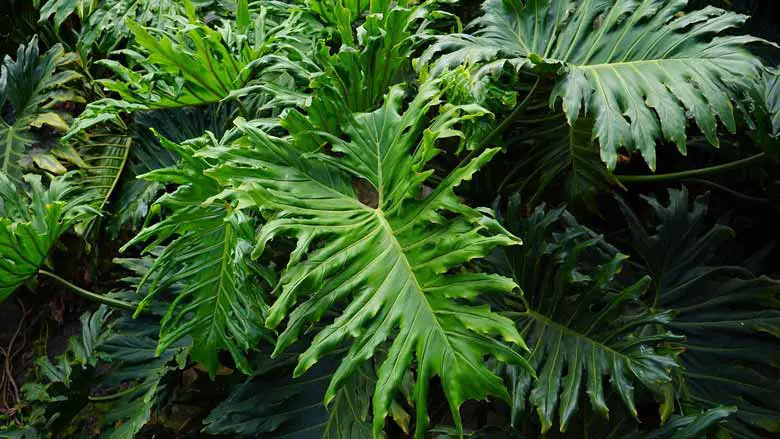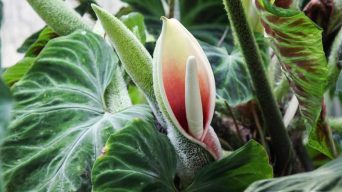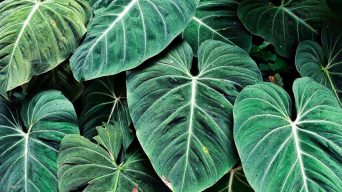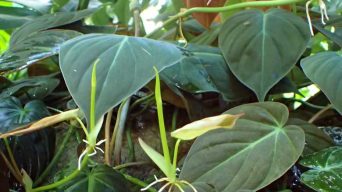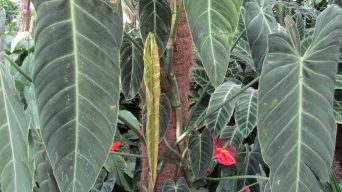Philodendron selloum, also known as tree philodendron, is a popular houseplant with large, glossy leaves.
It’s easy to grow and makes an attractive addition to any indoor space.
Philodendron selloum care is relatively straightforward.
With some know-how, you can keep your plant healthy and looking its best.
Here’s a complete guide to Philodendron selloum care and propagation.
Overview
| Family: | Araceae |
| Genus: | Thaumatophyllum |
| Botanical Name: | Thaumatophyllum bipinnatifidum |
| Synonyms: | Philodendron selloum, Philodendron bipinnatifidum |
| Common Names: | Split-leaf philodendron, lacy tree philodendron, selloum, horsehead philodendron |
| Origin: | South America |
| USDA Hardiness Zones: | 8b – 11 |
| Size: | 8 to 10 feet (2.5-3m) tall and 6 feet (1.8m) wide |
| Sun Exposure: | Bright, indirect sunlight |
| Water Needs: | Water thoroughly but infrequently |
| Soil Type: | Well-draining soil |
| Temperature: | Between 65 and 80 degrees Fahrenheit (18 – 27°C) |
| Humidity Levels: | 60-80% |
The genus Philodendron is a large one, with many species widely cultivated as ornamentals because of their attractive foliage.
Philodendron selloum, recently reclassified as Thaumatophyllum bipinnatifidum, is a fast-growing evergreen shrub that can reach 6-10 feet in height and 6-8 feet in width.
It is a native of South America, mainly from Brazil. Still, it has been introduced to many other countries and is found throughout the tropics.
The leaves are large and deeply lobed, with a leathery texture.
The leaf margins are often dentate or serrate.
The flowers are small and white, borne on an inflorescence that emerges from the leaf axils.
The Philodendron selloum is commonly known as:
- Split-leaf Philodendron
- Lacy Tree Philodendron
- Tree Philodendron
- Horsehead Philodendron
- Philodendron Hope Selloum
- Hope Philodendron
How To Care for Philodendron Selloum
Philodendron selloum is a robust plant that is relatively easy to care for.
With proper care, it will thrive indoors and provide years of enjoyment.
Here is what you need to know about Philodendron selloum care:
Sun Exposure & Light Requirements
Philodendron selloum is a tropical plant that thrives in warm, humid conditions.
It prefers bright indirect light but can tolerate some direct sunlight. However, too much direct sun can scorch the leaves.
It will tolerate some light shade, but too much shade will result in leggy growth.
Philodendron Hope needs at least 4 hours of bright light daily to maintain its lush, green foliage.
When growing philodendron selloum indoors, place the plant near an east- or west-facing window.
This will provide the bright indirect light that the plant needs.
If you don’t have a window that gets enough light, you can supplement with grow lights.
When growing philodendron selloum outdoors, place the plant in a spot with partial sun.
The morning sun is best as it won’t be as harsh as the afternoon sun.
If you live in a hot climate, it’s best to provide some afternoon shade to prevent the leaves from scorching.
Watering Requirements
The Philodendron selloum is a tropical plant that does best with consistent moisture. It’s essential to keep the soil evenly moist but not soggy.
Allow the top inch of soil to dry out in between watering.
The plant should be watered about once or twice a week during the growing season.
During the winter, cut back on watering slightly, allowing the top inch or so of soil to dry out completely between watering.
When watering, give your Philodendron selloum a good soaking and then allow the excess water to drain away.
Be sure to empty any water collected in the saucer or tray beneath the pot.
When watering, be sure to use lukewarm water. Cold water can shock the plant and cause leaf drop.
It’s also a good idea to use a water filter if your tap water is high in minerals, as this can build up over time and cause problems for the plant.
Soil Requirements
When caring for Philodendron selloum, it’s essential to use a loose, well-draining potting soil mix.
This plant doesn’t like to sit in wet soil, which can lead to root rot problems.
A good potting mix for Philodendron selloum would be a mixture of potting soil, peat moss, and perlite.
This mix will give the plant the necessary drainage while retaining moisture.
You can also add some compost to the mix to help provide extra nutrients.
A succulent or cactus mix can also be used, but add extra perlite or sand to ensure good drainage.
Temperature and Humidity
The Philodendron Selloum prefers warm weather and high humidity.
The ideal temperature range for this plant is between 60-85 degrees Fahrenheit.
When the temperature falls under 60°F, Philodendron leaves are prone to turning yellow and brown.
If the temperature rises above 85 degrees Fahrenheit, the leaves will wilt.
It’s best to keep this plant away from drafts and windows where it can be exposed to cold air.
The ideal humidity level for this plant is between 60-80%. If the humidity level drops below 60%, the leaves will turn brown and crispy.
To increase the humidity level around your Philodendron Selloum, you can do one or all of the following:
- Group your plants: This will create a microclimate around your plants that will be more humid than the surrounding area.
- Use a pebble tray: Place a layer of gravel or rocks in a shallow tray and add water. Place your Philodendron Selloum on top of the pebble tray. The water will evaporate and increase the humidity level around your plant.
- Use a humidifier: This is the most effective way to increase the humidity level around your Philodendron Hope.
Fertilizing
Philodendron selloum, like most plants, will benefit from regular fertilization.
Use a balanced fertilizer such as 20-20-20 or 10-10-10 at half strength monthly during the growing season (spring and summer).
A liquid fertilizer is best, but You can use a granular fertilizer if it is watered well.
Be careful not to over-fertilize, as this can burn the roots.
It’s best to apply fertilizer to moist soil to avoid root burn. Never fertilize a dry plant.
Hope Philodendron will also benefit from occasional applications of compost or manure.
Apply a thin layer of compost around the base of the plant in spring and summer.
You can also add a handful of manure to the planting hole when you transplant Philodendron selloum.
Avoid fertilizing in the winter when the plant is dormant, as this can damage the roots.
Potting and Repotting
Philodendron selloum are slow growers and usually only need to be repotted every 2-3 years.
The benefits of repotting are twofold.
Firstly, it allows you to give your plant some fresh soil containing more nutrients than the old soil.
Secondly, it allows you to check the roots for problems and gives the plant extra room to grow.
The best time to repot your plant is in the spring before new growth begins.
When repotting, choose a pot slightly larger than the current one.
This will help to prevent root rot and keep your plant healthy.
It’s also best to use a glazed pot with drainage holes to help prevent waterlogging.
To repot, gently remove the plant from its pot and loosen any compacted roots.
Place the plant in the new pot and fill in around it with fresh soil.
Water well and allow the soil to drain before placing the plant back in its spot.
Pruning
Philodendron selloum can be pruned at any time of year, but the best time is in late spring or early summer, just before new growth begins.
Pruning will encourage your plant to branch out and become bushier.
It’s best to use sharp, clean pruning shears to avoid damaging the plant.
To prune, cut any leggy or overgrown stems to the desired length.
Cut just above a leaf node (the point where a leaf is attached to the stem) to encourage new growth.
You can also remove any damaged or dead leaves. This will help to keep your plant healthy and looking its best.
Pests
Pests can become a problem with any plant, and Philodendron selloum is no exception.
Several types of pests are known to attack this plant, including mealybugs, aphids, spider mites, and scale insects.
Mealybugs are small, white, fuzzy insects that feed on plant sap. They can cause leaf yellowing and stunted growth.
Aphids are small, pear-shaped insects that feed by sucking plant sap. They can cause Philodendron leaf curling, stunted growth, and distortion of new leaves.
Spider mites are tiny spider-like creatures that feed on plant sap.
They can cause mottling and discoloration of leaves and webbing on the undersides of leaves.
Scale insects are small, hard-bodied insects that feed on plant sap.
They can cause yellowing, growth stunting, and a sticky residue on leaves.
If you notice these pests on your Hope Philodendron plant, it is vital to take action immediately.
Several ways to control pests include insecticidal soap, neem oil, or horticultural oil.
Using a cotton swab or a soft brush, you can remove pests by hand.
Introducing beneficial insects like ladybugs into your garden can also help control pests.
Diseases
Several diseases can affect Philodendron selloum, including root rot, leaf spot, and stem rot.
Philodendron root rot is caused by a fungus attacking the plant’s roots.
It’s usually the result of overwatering and causes the roots to turn black and mushy, leading to the death of the plant.
Leaf spot is caused by a fungus that attacks the plant leaves. Fungus thrives in moist, humid conditions, so keeping the leaves dry is essential.
It causes small, dark brown spots to form on the Philodendron leaves, which can eventually lead to leaf drop and plant death.
Stem rot is caused by a fungus that attacks the plant’s stems.
It can result from overwatering or damage to the stem and causes the stem to turn black and mushy.
Once stem rot has set in, it isn’t very easy to save the plant.
The best way to prevent diseases is to practice good plant hygiene, such as disinfecting your tools and pots and watering only when the soil is dry.
If you notice any signs of disease on your Philodendron selloum, it’s vital to take action immediately.
The best way to treat diseases is to cut away any affected parts of the plant and dispose of them in the trash.
You can also treat diseases with a fungicide, but following the labels’ directions is essential.
How to Care for Philodendron Selloum in Winter
The Philodendron Selloum is a tropical plant that originates from South America. It is a hardy plant that can tolerate some cold but will not survive if the temperature dips below freezing for an extended period.
If you live in an area with mild winters, you can keep your Philodendron Selloum outdoors year-round. If the winters are harsh where you live, you must bring your plant indoors for the winter months.
To keep your Philodendron Selloum healthy during the winter, it is crucial to provide extra care and attention.
Here are some tips on how to care for your Philodendron Selloum in winter:
- Water less frequently. The plant will go into semi-dormancy during winter and need less water. Allow the soil to dry out completely between watering.
- Place the plant in a bright but indirect location. The plant will need some light to thrive, but too much direct sunlight can scorch the leaves.
- Keep the humidity high. The plant will appreciate extra moisture during the winter, so mist the leaves regularly or place the plant on a pebble tray.
- Keep the temperature consistent. The plant will not tolerate sudden temperature changes, so ensure the room is warm and draft-free.
- Protect the plant from drafts. Ensure the plant is placed away from windows where cold drafts can reach it.
- Don’t fertilize. The plant will need less food during winter, so keep fertilizing until spring.
- Check for pests. Inspect the plant regularly for any signs of pests, such as aphids or mealybugs. If you see any pests, treat them immediately.
By following these tips, you can keep your Philodendron Selloum healthy and happy during the winter.
How To Propagate Philodendron Selloum
Philodendron selloum propagation is a simple process that just about anyone can do with success.
Stem cuttings or seeds can propagate this tropical plant, and it’s a great way to fill your home with more gorgeous plants.
Stem Cuttings
The easiest and most common way to propagate Philodendron selloum is by stem cuttings.
It can be done in water or directly in the soil, but I have found that starting the cuttings in water gives them a better chance of survival.
To propagate Philodendron selloum in water:
- Fill a clean glass or jar with fresh water.
- Cut a 4-6 inch piece of stem from a healthy philodendron selloum plant, making sure to cut just below a leaf node.
- Remove the bottom leaves from the cutting, leaving 2-3 leaves at the top.
- Place the cutting in the glass of water and put it in a spot out of direct sunlight.
- Change the water every few days to keep it fresh.
- In 4-6 weeks, you should see roots growing from the bottom of the cutting.
- Once the roots are an inch or two long, you can transplant the cutting into a pot filled with fresh potting soil.
- Water regularly and keep the soil moist but not soggy.
To propagate Philodendron selloum in soil:
- Fill a pot with fresh, well-draining potting soil.
- Cut a 4-6 inch piece of stem from a healthy philodendron selloum plant, making sure to cut just below a leaf node.
- Remove the bottom leaves from the cutting, leaving 2-3 leaves at the top.
- Dip the bottom of the cutting in rooting hormone powder.
- Stick the cutting into the soil, ensuring that at least 2 leaf nodes are buried.
- Water the soil until it is evenly moist, and then place the pot in bright, indirect light.
- Keep the soil moist but not soggy; you should see new growth within a few weeks.
- Once the plant has established itself, you can water it less frequently.
Remember that Philodendron selloum can be a slow grower, so don’t be discouraged if it takes a while for new growth to appear.
Be patient, and soon you’ll have a beautiful philodendron selloum of your own!
Seeds
Philodendron selloum can also be propagated from seed, although it is a bit more challenging than stem cuttings.
The seeds are tiny and need to be handled with care.
To propagate philodendron selloum from seed:
- Fill a pot with fresh, well-draining potting soil.
- Sow the seeds on the soil’s surface and lightly press them into the soil.
- Water the soil until it is evenly moist, and then place the pot in a spot with bright, indirect light.
- Keep the soil moist but not soggy; you should see new growth within a few weeks.
- Once the seedlings are a few inches tall, you can transplant them into individual pots.
- Water regularly and keep the soil moist but not soggy.
Propagating from seeds is also a slower process, so if you’re in a hurry to fill your home with these plants, stem cuttings are the way to go.
That being said, propagating philodendron selloum from seed can be a fun and rewarding experience.
With some care and patience, you can successfully propagate philodendron selloum from seed.
Final Thoughts
Philodendron selloum care is not complex, and this plant can be an excellent addition to your home.
With some care, you can have a Philodendron selloum that thrives and looks beautiful.
Propagating philodendron selloum is also relatively easy, so if you want more plants, it is something you can do.
All in all, the Philodendron selloum is an excellent plant for anyone, whether you are an experienced gardener or someone who is just starting.

